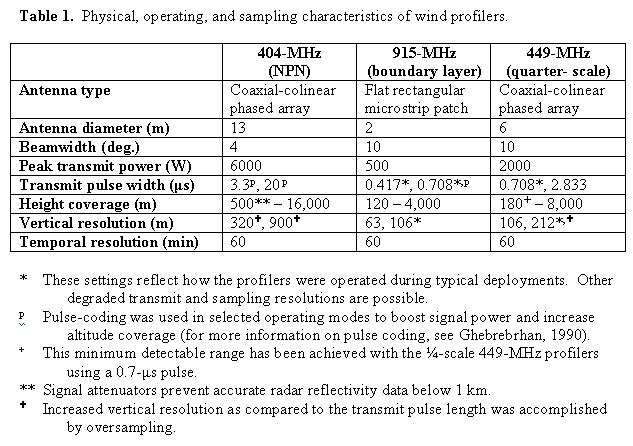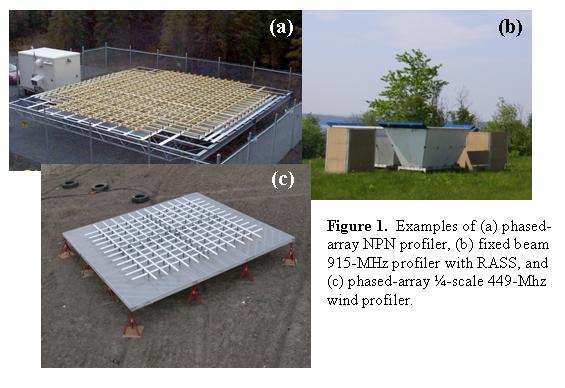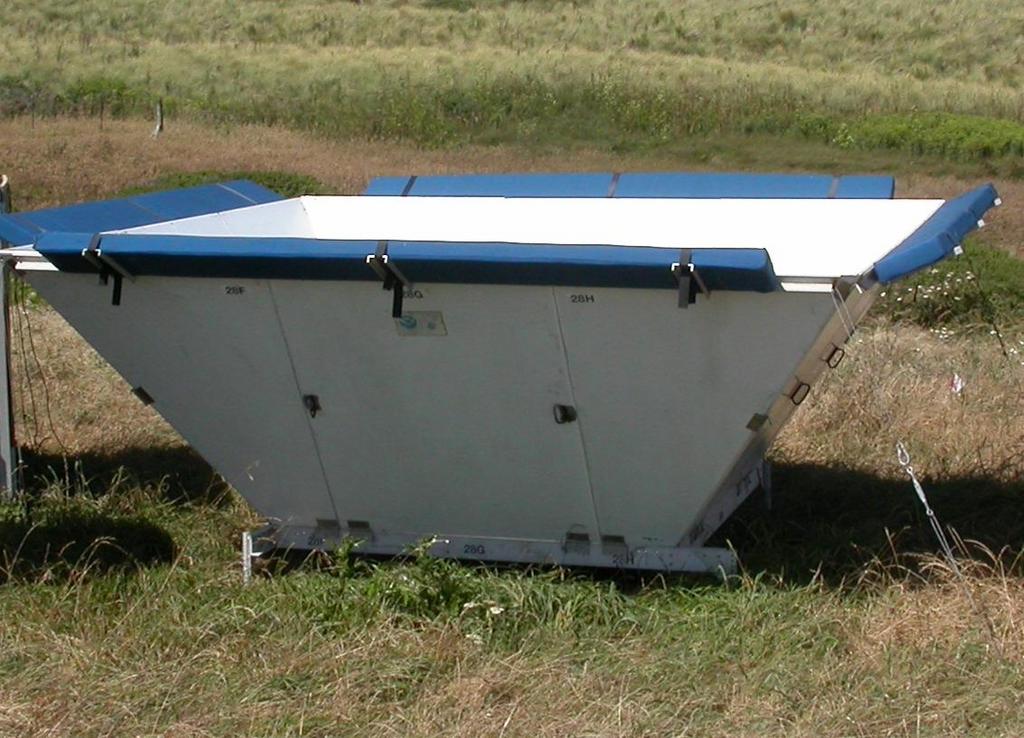Wind Profilers
Wind profilers are Doppler radars that most often operate in the VHF (30-300 MHz) or UHF (300-1000 MHz) frequency bands. There are three primary types of radar wind profilers in operation in the U.S. today. The
NOAA Profiler Network (NPN) profiler operates at a frequency of 404 MHz (Table 1, Fig. 1a). The second type of profiler that is used by NOAA research and outside agencies is the 915-MHz boundary-layer profiler (Table 1, Fig. 1b). The 404-MHz profilers are more expensive to build and operate, but they provide the deepest coverage of the atmosphere. The 915-MHz profilers are smaller and cheaper to build and operate, but they lack height coverage much above the boundary layer. A third type of profiler that operates at 449 MHz (the so-called 1/4-scale 449-MHz profilers) combines the best sampling attributes of the other two systems (Table 1, Fig. 1c).


Wind profilers transmit pulses of electromagnetic radiation vertically and in at least two slightly off-vertical (~75 degree elevation) directions in order to resolve the three-dimensional vector wind. A small amount of the energy transmitted in each direction is reflected or backscattered to the radar. The backscatter returns are Doppler shifted by the motion of the scattering media. The return signals are sampled in the receiver at discrete intervals called range gates. If the sampling interval is the same as the length of the transmitted pulse, then adjacent range gates are produced. The transmit pulse is usually on the order of hundreds to thousands of nanoseconds (ns). For example, a 700 ns pulse translates into a non-oversampled range resolution of 105 m.
Profilers receive backscatter returns from atmospheric features (turbulence, clouds, precipitation) and non-atmospheric features (insects, birds, trees, airplanes, radio frequency interference). The challenge in signal processing is to avoid the returns from non-atmospheric scattering targets and focus on the atmospheric returns. To do this, profilers integrate thousands of consecutive samples to boost the signal-to-noise ratio of the atmospheric returns, a process known as coherent integration. A set of coherent integrations is processed via Fast Fourier Transform to produce a single Doppler velocity spectrum, and a set of spectra are averaged together to improve the detectability of the spectral peak. The strongest peak in the spectrum is analyzed and assumed to be the peak resulting from atmospheric backscatter. A new commercially available signal processing algorithm identifies multiple peaks and uses pattern recognition to determine which peaks are most likely to be the result of atmospheric returns.
The spectral peak is analyzed to produce a set of Doppler spectral moments, the first three of which correspond to the signal power, radial velocity, and spectral width. This is repeated for each range gate and for each of the three transmitted beam directions. A wind profile is constructed by geometrically transforming the radial velocities into the meteorological coordinate system. A single wind profile is produced over an observing period of 30 to 90 s. All of the wind profiles measured within a specified averaging period (15 min to 60 min) are averaged together using a consensus routine. The consensus routine filters outliers using threshold and acceptance windows. The consensus wind profiles are recorded on site and transmitted back to a data hub in Boulder, Colorado, via phone lines or, in remote areas, via satellite communications.
Publications
A UHF Wind Profiler for the Boudary Layer: Breif Description and Initial Results
Research Applications of a Boundary-Layer Wind Profiler
An Evaluation of Wind Profiler, RASS, and Microwave Radiometer Performance


 Wind profilers transmit pulses of electromagnetic radiation vertically and in at least two slightly off-vertical (~75 degree elevation) directions in order to resolve the three-dimensional vector wind. A small amount of the energy transmitted in each direction is reflected or backscattered to the radar. The backscatter returns are Doppler shifted by the motion of the scattering media. The return signals are sampled in the receiver at discrete intervals called range gates. If the sampling interval is the same as the length of the transmitted pulse, then adjacent range gates are produced. The transmit pulse is usually on the order of hundreds to thousands of nanoseconds (ns). For example, a 700 ns pulse translates into a non-oversampled range resolution of 105 m.
Profilers receive backscatter returns from atmospheric features (turbulence, clouds, precipitation) and non-atmospheric features (insects, birds, trees, airplanes, radio frequency interference). The challenge in signal processing is to avoid the returns from non-atmospheric scattering targets and focus on the atmospheric returns. To do this, profilers integrate thousands of consecutive samples to boost the signal-to-noise ratio of the atmospheric returns, a process known as coherent integration. A set of coherent integrations is processed via Fast Fourier Transform to produce a single Doppler velocity spectrum, and a set of spectra are averaged together to improve the detectability of the spectral peak. The strongest peak in the spectrum is analyzed and assumed to be the peak resulting from atmospheric backscatter. A new commercially available signal processing algorithm identifies multiple peaks and uses pattern recognition to determine which peaks are most likely to be the result of atmospheric returns.
The spectral peak is analyzed to produce a set of Doppler spectral moments, the first three of which correspond to the signal power, radial velocity, and spectral width. This is repeated for each range gate and for each of the three transmitted beam directions. A wind profile is constructed by geometrically transforming the radial velocities into the meteorological coordinate system. A single wind profile is produced over an observing period of 30 to 90 s. All of the wind profiles measured within a specified averaging period (15 min to 60 min) are averaged together using a consensus routine. The consensus routine filters outliers using threshold and acceptance windows. The consensus wind profiles are recorded on site and transmitted back to a data hub in Boulder, Colorado, via phone lines or, in remote areas, via satellite communications.
Wind profilers transmit pulses of electromagnetic radiation vertically and in at least two slightly off-vertical (~75 degree elevation) directions in order to resolve the three-dimensional vector wind. A small amount of the energy transmitted in each direction is reflected or backscattered to the radar. The backscatter returns are Doppler shifted by the motion of the scattering media. The return signals are sampled in the receiver at discrete intervals called range gates. If the sampling interval is the same as the length of the transmitted pulse, then adjacent range gates are produced. The transmit pulse is usually on the order of hundreds to thousands of nanoseconds (ns). For example, a 700 ns pulse translates into a non-oversampled range resolution of 105 m.
Profilers receive backscatter returns from atmospheric features (turbulence, clouds, precipitation) and non-atmospheric features (insects, birds, trees, airplanes, radio frequency interference). The challenge in signal processing is to avoid the returns from non-atmospheric scattering targets and focus on the atmospheric returns. To do this, profilers integrate thousands of consecutive samples to boost the signal-to-noise ratio of the atmospheric returns, a process known as coherent integration. A set of coherent integrations is processed via Fast Fourier Transform to produce a single Doppler velocity spectrum, and a set of spectra are averaged together to improve the detectability of the spectral peak. The strongest peak in the spectrum is analyzed and assumed to be the peak resulting from atmospheric backscatter. A new commercially available signal processing algorithm identifies multiple peaks and uses pattern recognition to determine which peaks are most likely to be the result of atmospheric returns.
The spectral peak is analyzed to produce a set of Doppler spectral moments, the first three of which correspond to the signal power, radial velocity, and spectral width. This is repeated for each range gate and for each of the three transmitted beam directions. A wind profile is constructed by geometrically transforming the radial velocities into the meteorological coordinate system. A single wind profile is produced over an observing period of 30 to 90 s. All of the wind profiles measured within a specified averaging period (15 min to 60 min) are averaged together using a consensus routine. The consensus routine filters outliers using threshold and acceptance windows. The consensus wind profiles are recorded on site and transmitted back to a data hub in Boulder, Colorado, via phone lines or, in remote areas, via satellite communications.